Abarth 2
 Abarth cars with Fiat bodyshells
Abarth cars with Fiat bodyshells
On this page are covered cars which used the body from other manufacturers (mainly Fiat). Cars which used unique bodies are covered on a separate page.
Fiat 500 bodied cars
The first of the famous Abarth 500s appeared at the Turin Motorshow of 1957. Without changing the engine displacement power was up to 20bhp. When Fiat released the 499cc 500 Sport in the following year Abarth squeezed 33bhp from its powerplant. After these versions Abarth started increasing the capacity of the engine, first to a nominal 595 and later to 695.
595/595SS & 695/695SS
Based
on the Fiat 500D, the 595 was introduced
in 1963. The engine was enlarged to 593.7cc by increasing the bore and
numerous other modifications were made to the inlet and exhaust manifolds,
camshaft, sparkplugs, cylinder head, pistons, valve springs etc. The end
result produced 27bhp. The car was otherwise little changed, a revcounter
and oil pressure guage being options.
The following year saw the arrival of the still
more potent (32bhp thanks mainly to a new carburettor) 595SS and the new
695 and 695SS. The latter cars had a 689,5cc engine with 30 and 38bhp respectively.
Again designed for competition, the 695SS was avialable with numerous options such as disc brakes (at the front).
The 695 was discontinued in 1966, whilst the 695SS
also became available with widened wheelarches. Production of these cars
(the 595, 595SS and 695SS) continued until 1971.
Fiat 600 bodied cars
In 1956 Abarth presented their first version of the
Fiat 600, in 1959 this got a more powerful 747cc engine with 42bhp. More
well known was the 850TC released in February 1961. Based on the 600D,
Later, in 1968, the 850TC got 78bhp and in a Group
5 racing version 93bhp @ 8,400rpm, whilst the 1000 had its power increased
to 88bhp in the Group 2 version and an impressive 110bhp in the Group 5
version. The final version of the 1000 car emerged in 1970 with the redesigned
'radiale' cylinder head, a compression ratio of 13:1 and 112bhp, not bad
for a car weighing 583kg ready to run !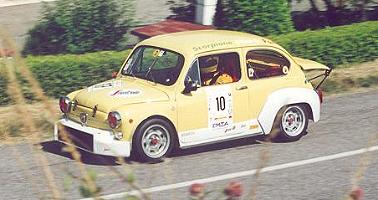 this featured a heavily modified engine (847cc with 52bhp @ 5,800rpm),
suspension, fuel feed and exhaust system as well as having an extra radiator
and disc brakes at the front. Two higher levels of tuning were available,
the 850S with 55bhp and the 850SS with 57bhp, the main difference being
the increased compression ratio.
this featured a heavily modified engine (847cc with 52bhp @ 5,800rpm),
suspension, fuel feed and exhaust system as well as having an extra radiator
and disc brakes at the front. Two higher levels of tuning were available,
the 850S with 55bhp and the 850SS with 57bhp, the main difference being
the increased compression ratio.
A year later Abarth fitted a 982cc engine into the
600D bodyshell, creating the 1000. This had 60bhp as standard, but a 66bhp
version with disc brakes at the rear and a five-speed gearbox was also
made for motorsport. The latter had a compression ratio of 12.8:1 !
The next development was a twin-cam 850 engine,
with 58bhp (or 60bhp in the competition version), introduced in 1963. As
some other versions, disc brakes were fitted all round and a radiator was
fitted at the front on the competition car. Logically, twin-camshafts then
followed for the 1000 engine, thus liberating 80bhp @ 7,400rpm.
Fiat 850 berlina bodied cars
Predictably, shortly after Fiat released the new 850 in 1964, Abarth introduced his versions. These started with the OT850, available with either 42 or 50bhp and were essentially the production cars, although the more powerful version did also have disc brakes at the front. These were very rapidly followed by the OT1000 which had a 982cc powerplant with 54bhp. Adding 100bhp created the OT1600, see below.
OT1600
A Fiat 850 after a serious course of steriods, the
OT1600 was first seen at the Turin Motorshow in 1964. It featured heavily
revised suspension, larger wheelarches with extensions to house the bigger
wheels, comprehensive instrumentation (revcounter, speedometer, water and
oil temperature, oil pressure and fuel level) and different seats. Behind
the revised front grille sat two radiators, one each for the water and
oil. Disc brakes were fitted all round.
The engine was a 1592cc (86x68.5mm) dohc twin-spark
with two twin carburettors and 154bhp @ 7,600rpm. A four or six speed transmission
could be fitted, complete with limited slip differential.
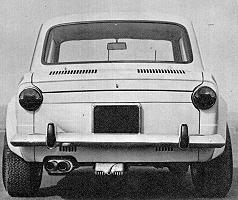 |
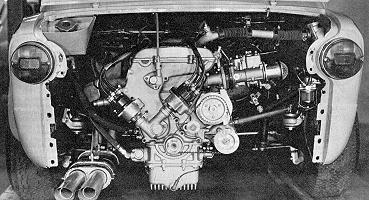 |
Fiat 850 coupé and spider bodied cars
Further, more radical developments, ot the 850 coupé
used larger capacity engines. First came the 75bhp OT1300/124, the designation
indicating the 124 heritage of the powerplant, which was increased in capacity
from the original 1197cc to 1280cc. The next logical (?!) step was to fit
a 2-litre unit, see below.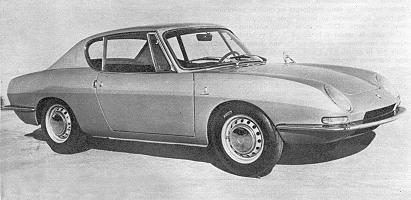 1965 saw the birth of yet more 982cc engined cars.
The 62bhp unit was fitted to both the 850 Spider and the new 850 Coupé,
creating in both cases an OT1000. A coupé with 74bhp (mainly thanks
to the fitment of two twin carburettors), known as the OTS1000
was also offered. At the same time a Bertone Racer (ie 850 Spider with
a permanent hardtop) was fitted with a more highly tuned 'radial' engine
(hence the designation OTR1000), still 982cc but with 74bhp thanks to the
completely redesigned cylinder head. For motorsport the OTSS1000 was built
which managed to extract 90bhp from the OTS engine.
1965 saw the birth of yet more 982cc engined cars.
The 62bhp unit was fitted to both the 850 Spider and the new 850 Coupé,
creating in both cases an OT1000. A coupé with 74bhp (mainly thanks
to the fitment of two twin carburettors), known as the OTS1000
was also offered. At the same time a Bertone Racer (ie 850 Spider with
a permanent hardtop) was fitted with a more highly tuned 'radial' engine
(hence the designation OTR1000), still 982cc but with 74bhp thanks to the
completely redesigned cylinder head. For motorsport the OTSS1000 was built
which managed to extract 90bhp from the OTS engine.
Abarth OT2000
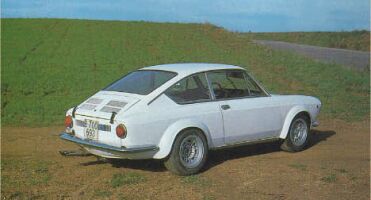 A further development of the OT1000, and still using
a modified Fiat 850 bodyshell, the OT2000 used a 1964cc Abarth/Simca twin-cam
engine with twin 45 DCOE carburettors which managed to produce around 185bhp.
As usual with Abarths, production figures are rather uncertain, but very
few, probably less than five, were built.
A further development of the OT1000, and still using
a modified Fiat 850 bodyshell, the OT2000 used a 1964cc Abarth/Simca twin-cam
engine with twin 45 DCOE carburettors which managed to produce around 185bhp.
As usual with Abarths, production figures are rather uncertain, but very
few, probably less than five, were built.
Used heavily in motorsport, the OTS&SS were
continually developed, until by 1970 the most powerful version featured
a five speed transmission, Kugelfischer fuel injection, and produced 103bhp!
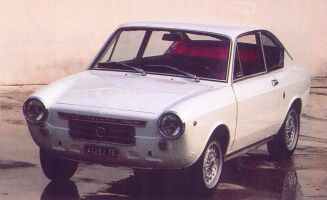 |
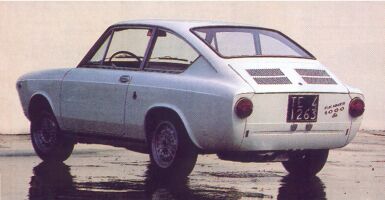 |
Fiat 1500 bodied cars
In 1961 Abarth launched a 1500S Rally, designed for the latter sport. Externally almost identical to the production car, it had 108bhp @ 5,800rpm (up from 72 in the standard car !) and disc brakes all round.
Abarth comment form
| Main Abarth Page | Historic Abarths (unique bodies) | Grande Punto Abarth | 500 Abarth |
Copyright © 2000 to 2008 CarsfromItaly